Analyzing Segregation and Assimilation's Effects on Aboriginal Health
VerifiedAdded on 2023/06/10
|14
|1261
|294
Presentation
AI Summary
This presentation critically analyzes the impact of the segregation and assimilation eras on the health outcomes of Australia's First Peoples. It examines the key themes of these policies, including the forced separation and cultural assimilation of Indigenous communities. The presentation explores the contemporary impacts of these policies, such as the ongoing health disparities, mistrust in healthcare systems, and the perpetuation of stereotypes. It also discusses the effects of these policies on building trustful and respectful relationships between First Peoples and healthcare professionals. The presentation highlights how historical injustices continue to affect access to healthcare, mental health, and overall well-being, emphasizing the need for culturally sensitive approaches and a deeper understanding of the historical context. The presentation concludes with a call to action, urging healthcare professionals to recognize and address the historical and ongoing impacts of these policies to improve the health outcomes and build stronger relationships with Indigenous communities. The presentation uses a range of academic references to support its analysis.
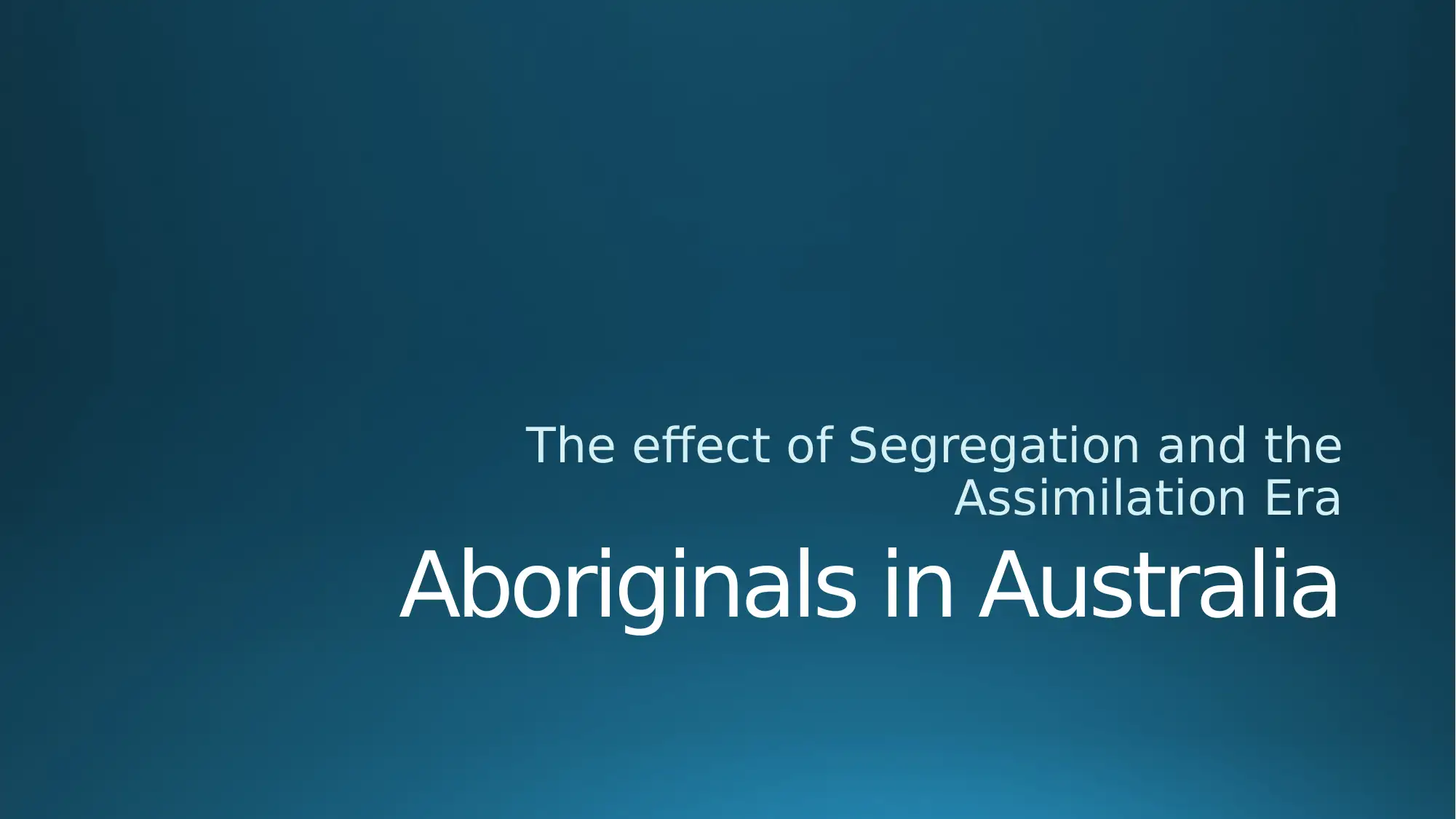
Aboriginals in Australia
The effect of Segregation and the
Assimilation Era
The effect of Segregation and the
Assimilation Era
Paraphrase This Document
Need a fresh take? Get an instant paraphrase of this document with our AI Paraphraser
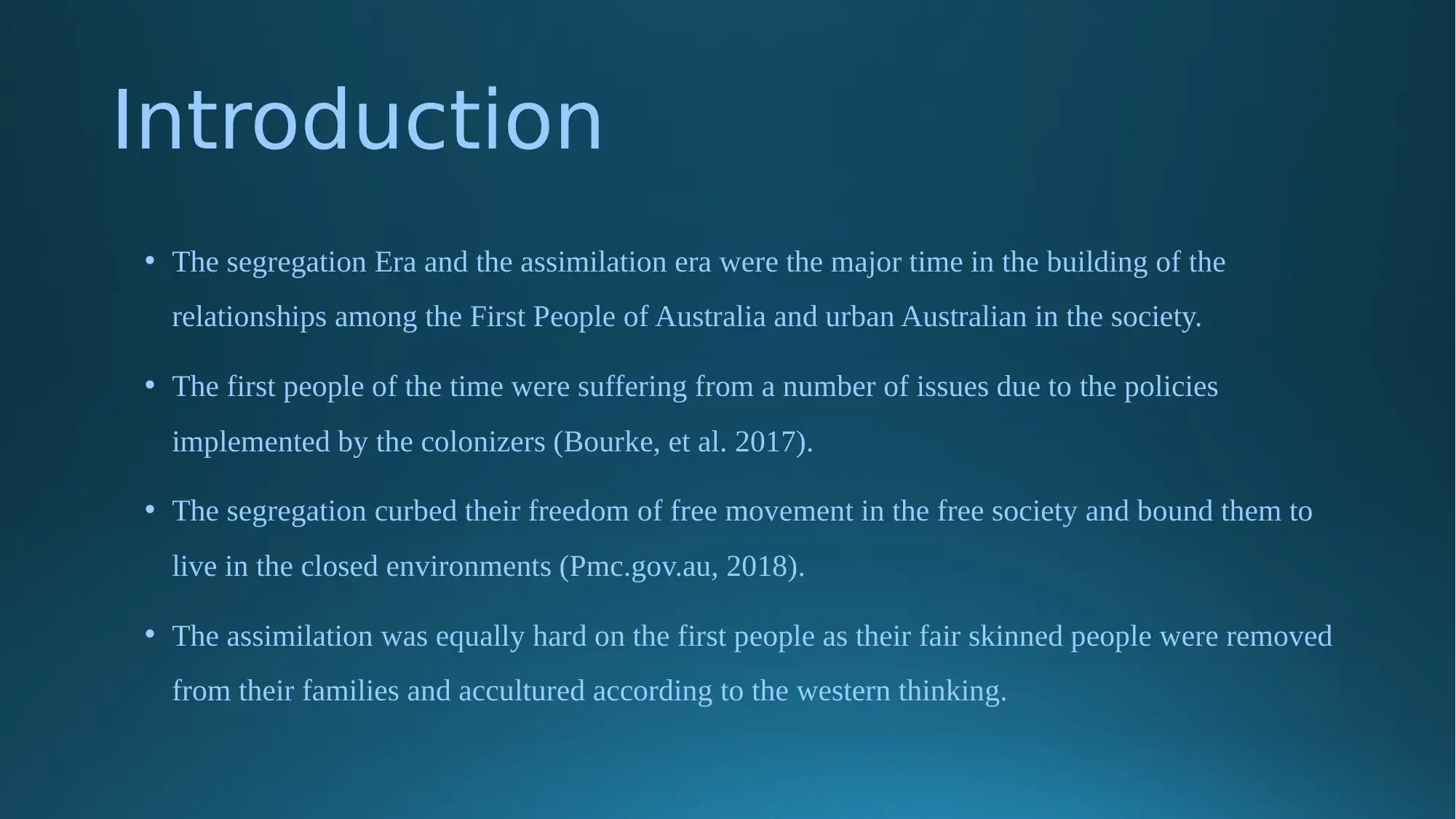
Introduction
• The segregation Era and the assimilation era were the major time in the building of the
relationships among the First People of Australia and urban Australian in the society.
• The first people of the time were suffering from a number of issues due to the policies
implemented by the colonizers (Bourke, et al. 2017).
• The segregation curbed their freedom of free movement in the free society and bound them to
live in the closed environments (Pmc.gov.au, 2018).
• The assimilation was equally hard on the first people as their fair skinned people were removed
from their families and accultured according to the western thinking.
• The segregation Era and the assimilation era were the major time in the building of the
relationships among the First People of Australia and urban Australian in the society.
• The first people of the time were suffering from a number of issues due to the policies
implemented by the colonizers (Bourke, et al. 2017).
• The segregation curbed their freedom of free movement in the free society and bound them to
live in the closed environments (Pmc.gov.au, 2018).
• The assimilation was equally hard on the first people as their fair skinned people were removed
from their families and accultured according to the western thinking.
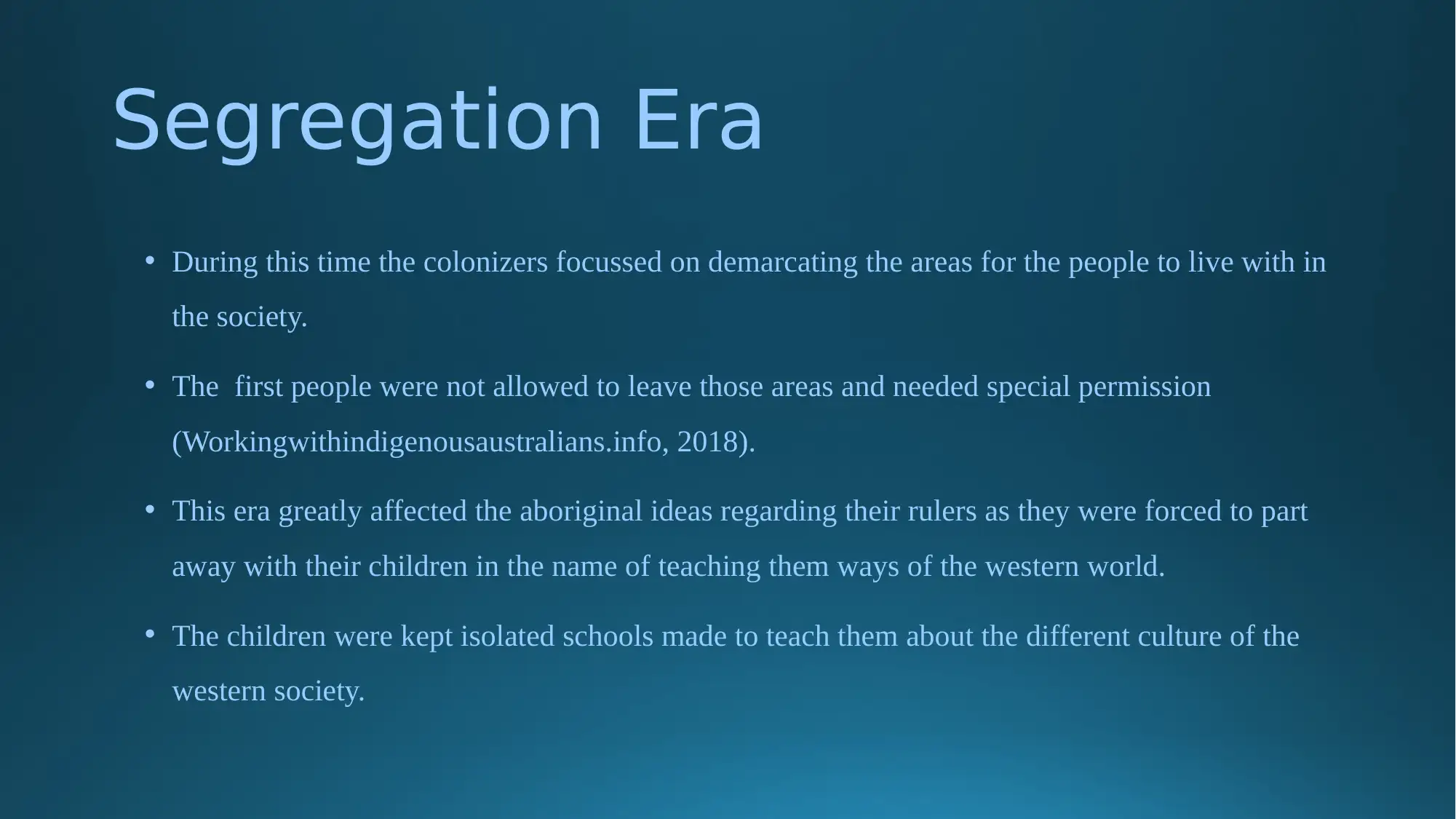
Segregation Era
• During this time the colonizers focussed on demarcating the areas for the people to live with in
the society.
• The first people were not allowed to leave those areas and needed special permission
(Workingwithindigenousaustralians.info, 2018).
• This era greatly affected the aboriginal ideas regarding their rulers as they were forced to part
away with their children in the name of teaching them ways of the western world.
• The children were kept isolated schools made to teach them about the different culture of the
western society.
• During this time the colonizers focussed on demarcating the areas for the people to live with in
the society.
• The first people were not allowed to leave those areas and needed special permission
(Workingwithindigenousaustralians.info, 2018).
• This era greatly affected the aboriginal ideas regarding their rulers as they were forced to part
away with their children in the name of teaching them ways of the western world.
• The children were kept isolated schools made to teach them about the different culture of the
western society.
⊘ This is a preview!⊘
Do you want full access?
Subscribe today to unlock all pages.

Trusted by 1+ million students worldwide
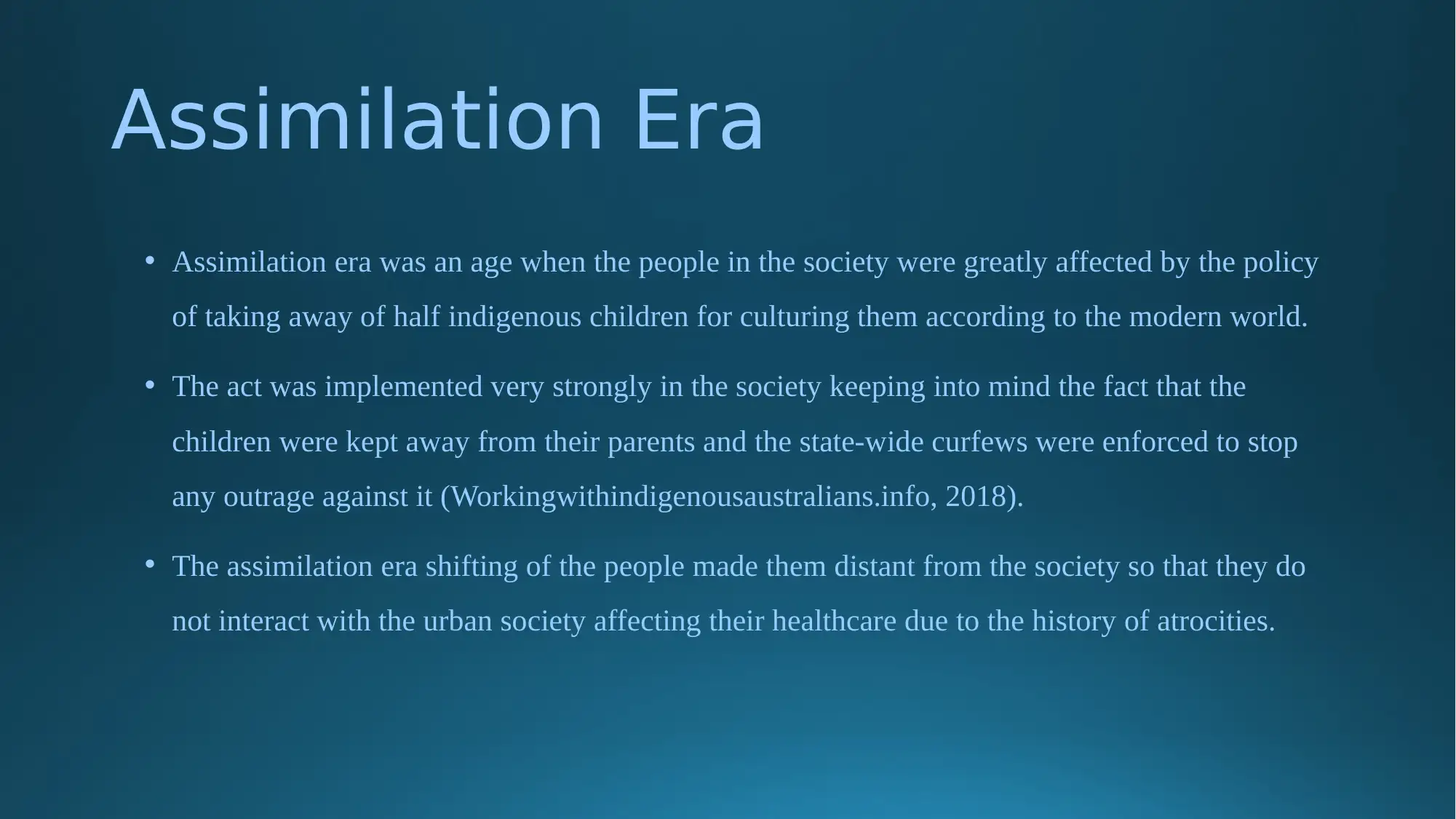
Assimilation Era
• Assimilation era was an age when the people in the society were greatly affected by the policy
of taking away of half indigenous children for culturing them according to the modern world.
• The act was implemented very strongly in the society keeping into mind the fact that the
children were kept away from their parents and the state-wide curfews were enforced to stop
any outrage against it (Workingwithindigenousaustralians.info, 2018).
• The assimilation era shifting of the people made them distant from the society so that they do
not interact with the urban society affecting their healthcare due to the history of atrocities.
• Assimilation era was an age when the people in the society were greatly affected by the policy
of taking away of half indigenous children for culturing them according to the modern world.
• The act was implemented very strongly in the society keeping into mind the fact that the
children were kept away from their parents and the state-wide curfews were enforced to stop
any outrage against it (Workingwithindigenousaustralians.info, 2018).
• The assimilation era shifting of the people made them distant from the society so that they do
not interact with the urban society affecting their healthcare due to the history of atrocities.
Paraphrase This Document
Need a fresh take? Get an instant paraphrase of this document with our AI Paraphraser
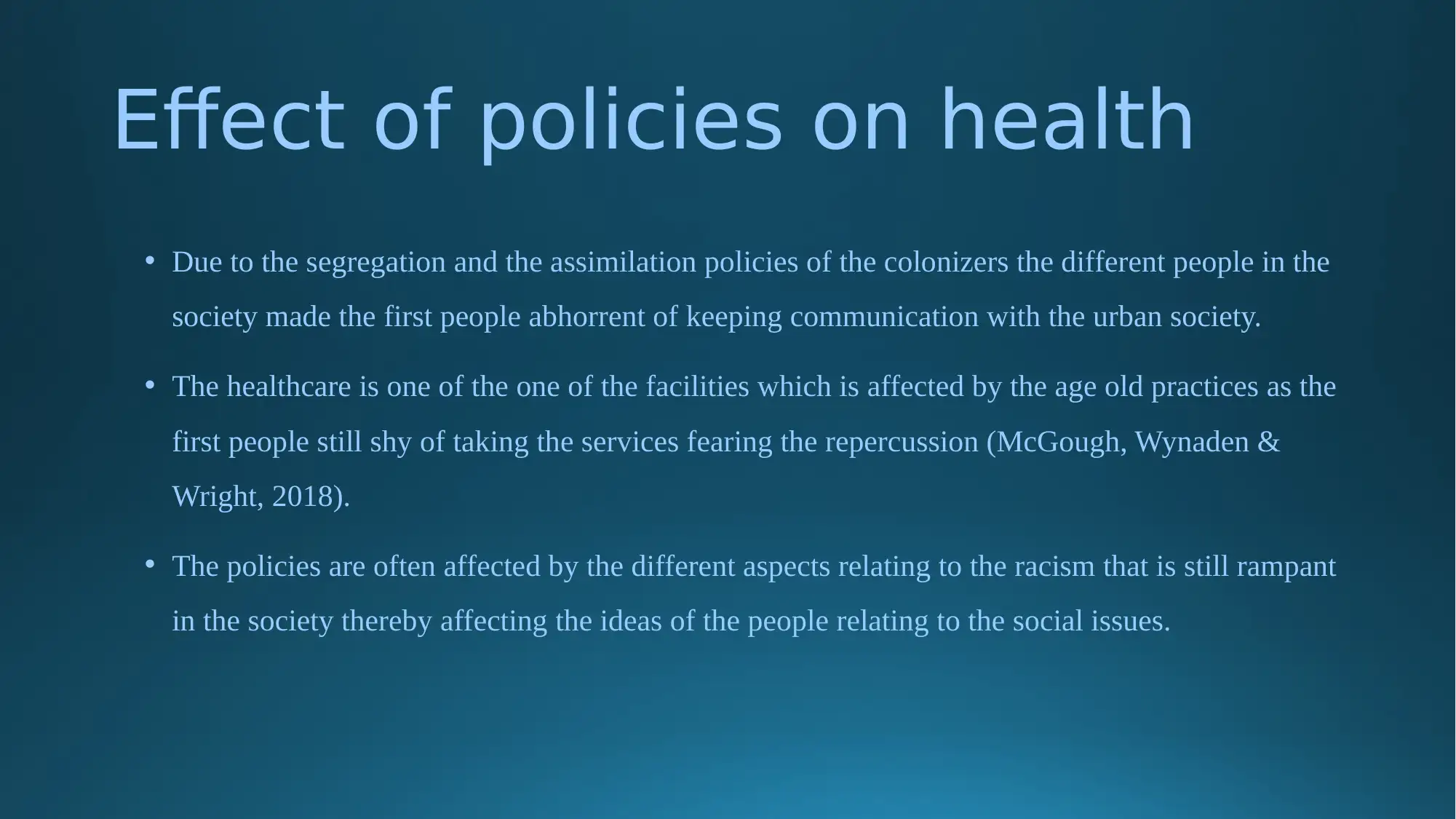
Effect of policies on health
• Due to the segregation and the assimilation policies of the colonizers the different people in the
society made the first people abhorrent of keeping communication with the urban society.
• The healthcare is one of the one of the facilities which is affected by the age old practices as the
first people still shy of taking the services fearing the repercussion (McGough, Wynaden &
Wright, 2018).
• The policies are often affected by the different aspects relating to the racism that is still rampant
in the society thereby affecting the ideas of the people relating to the social issues.
• Due to the segregation and the assimilation policies of the colonizers the different people in the
society made the first people abhorrent of keeping communication with the urban society.
• The healthcare is one of the one of the facilities which is affected by the age old practices as the
first people still shy of taking the services fearing the repercussion (McGough, Wynaden &
Wright, 2018).
• The policies are often affected by the different aspects relating to the racism that is still rampant
in the society thereby affecting the ideas of the people relating to the social issues.
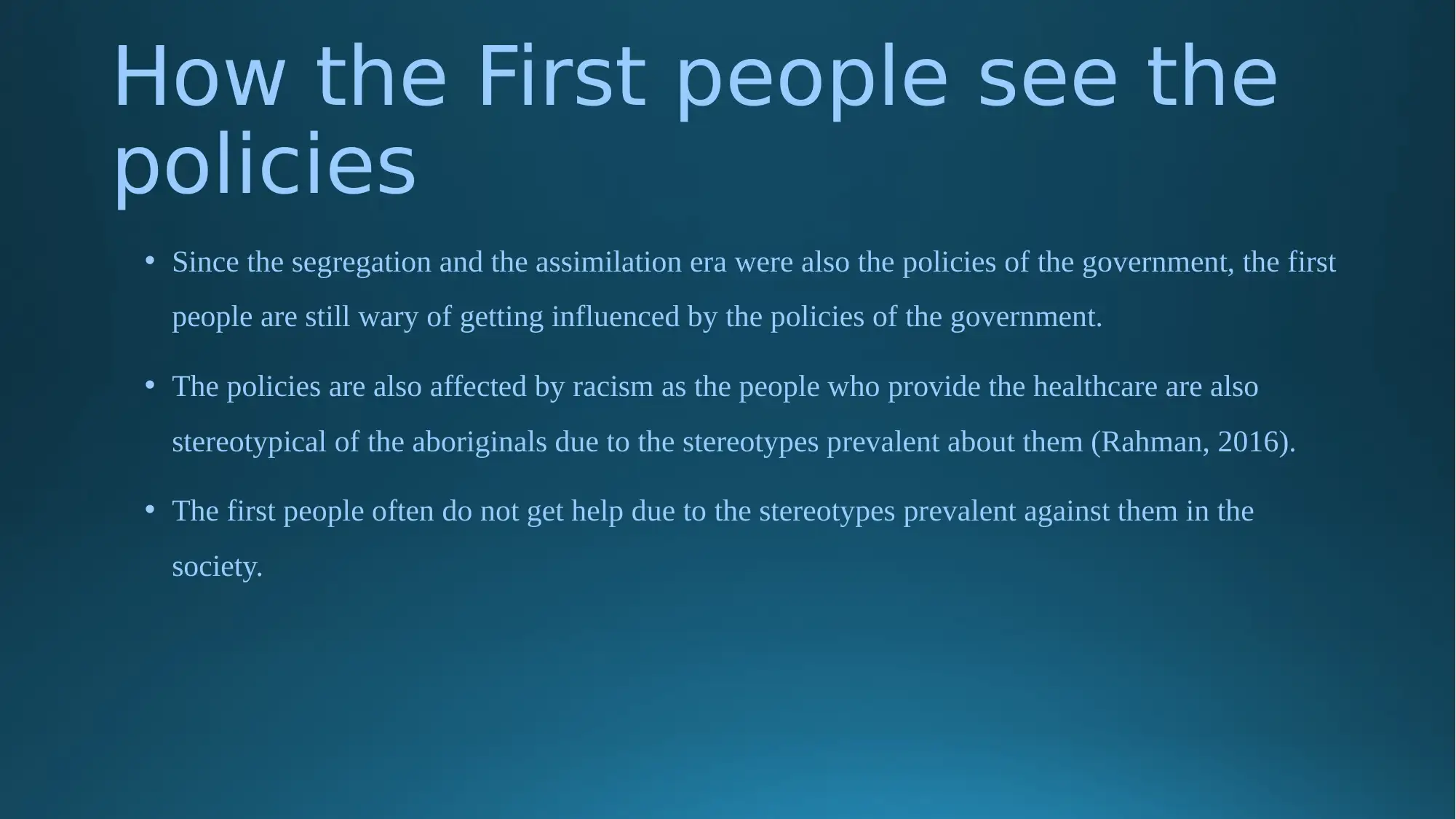
How the First people see the
policies
• Since the segregation and the assimilation era were also the policies of the government, the first
people are still wary of getting influenced by the policies of the government.
• The policies are also affected by racism as the people who provide the healthcare are also
stereotypical of the aboriginals due to the stereotypes prevalent about them (Rahman, 2016).
• The first people often do not get help due to the stereotypes prevalent against them in the
society.
policies
• Since the segregation and the assimilation era were also the policies of the government, the first
people are still wary of getting influenced by the policies of the government.
• The policies are also affected by racism as the people who provide the healthcare are also
stereotypical of the aboriginals due to the stereotypes prevalent about them (Rahman, 2016).
• The first people often do not get help due to the stereotypes prevalent against them in the
society.
⊘ This is a preview!⊘
Do you want full access?
Subscribe today to unlock all pages.

Trusted by 1+ million students worldwide
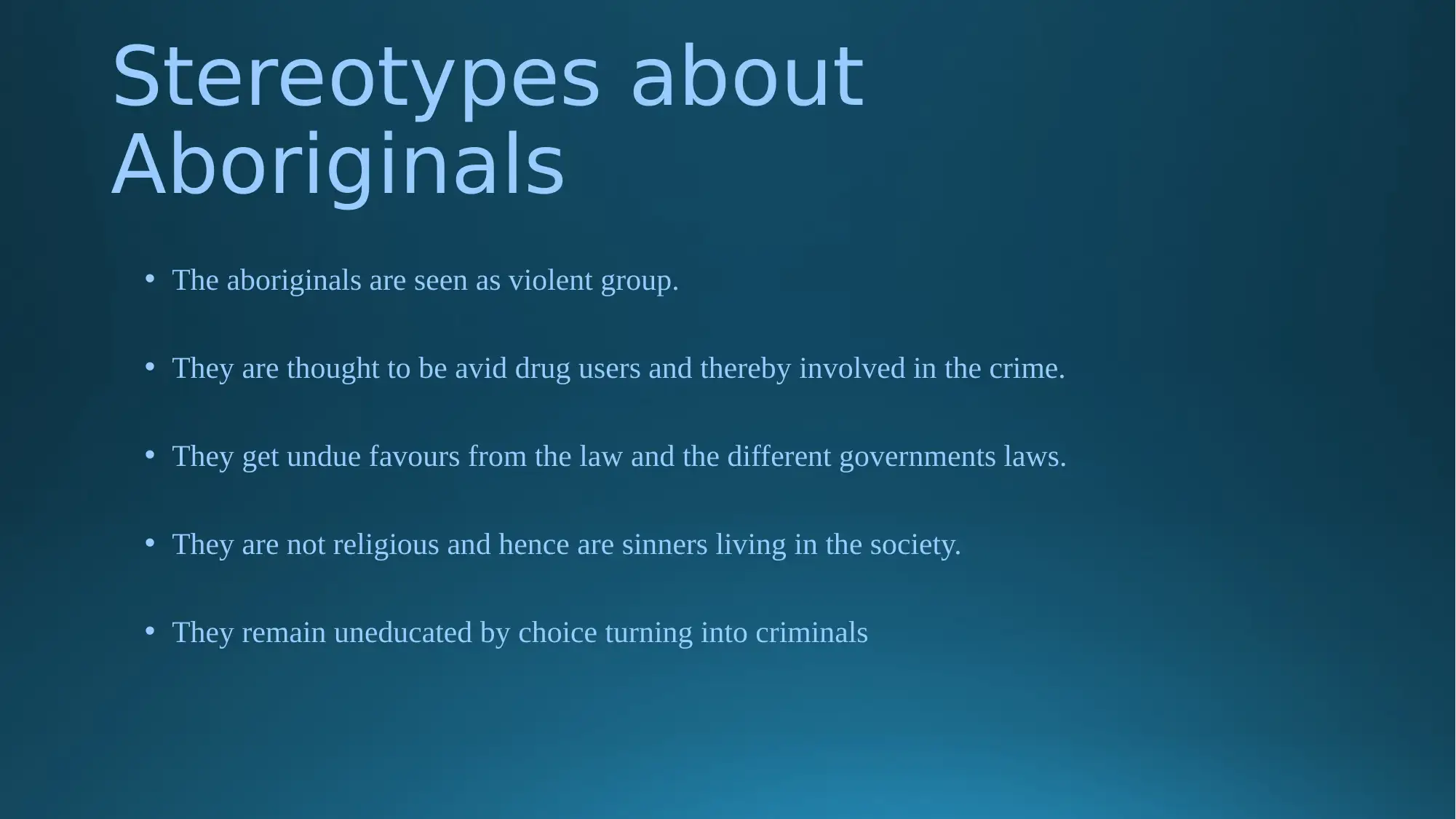
Stereotypes about
Aboriginals
• The aboriginals are seen as violent group.
• They are thought to be avid drug users and thereby involved in the crime.
• They get undue favours from the law and the different governments laws.
• They are not religious and hence are sinners living in the society.
• They remain uneducated by choice turning into criminals
Aboriginals
• The aboriginals are seen as violent group.
• They are thought to be avid drug users and thereby involved in the crime.
• They get undue favours from the law and the different governments laws.
• They are not religious and hence are sinners living in the society.
• They remain uneducated by choice turning into criminals
Paraphrase This Document
Need a fresh take? Get an instant paraphrase of this document with our AI Paraphraser
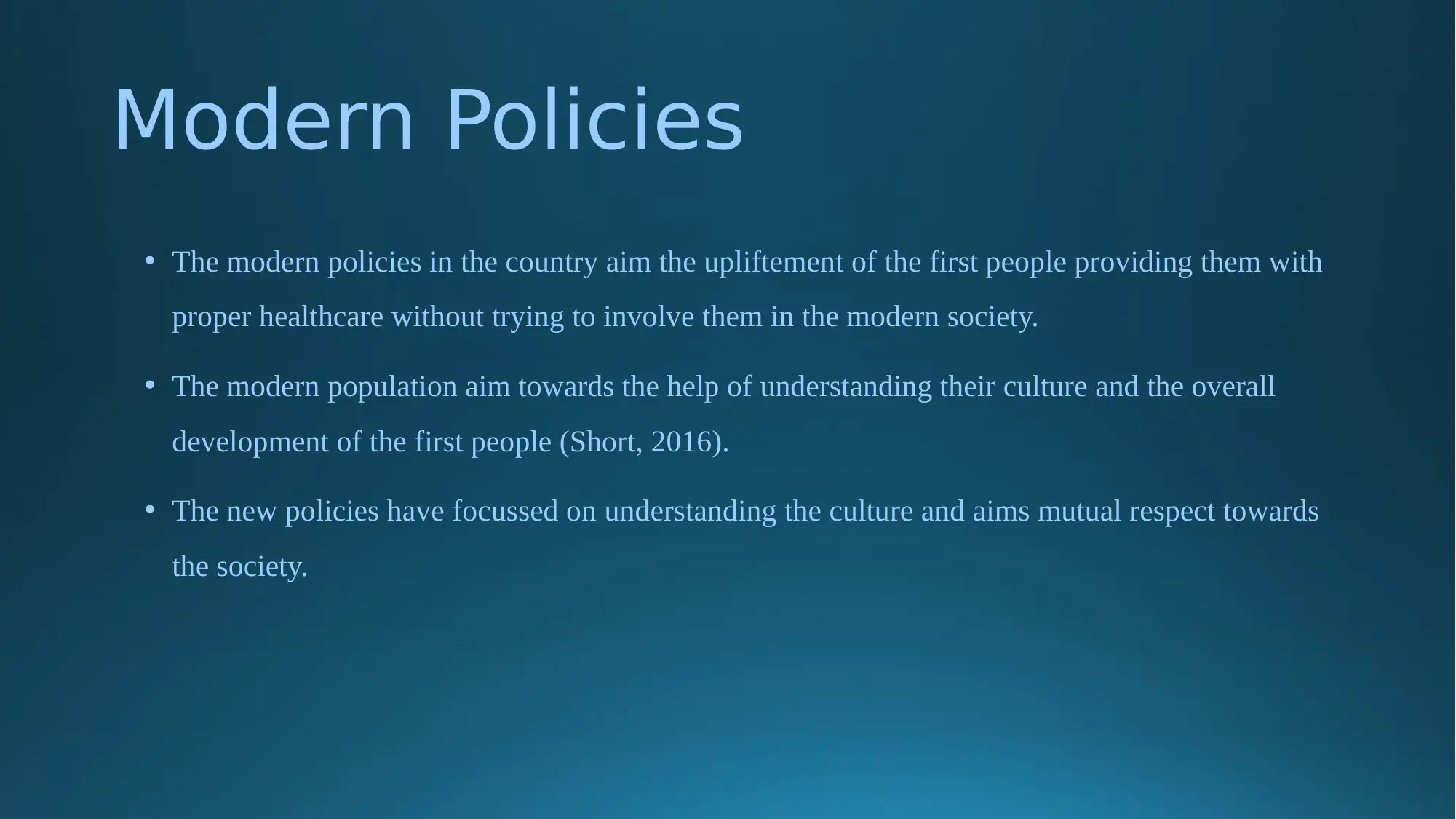
Modern Policies
• The modern policies in the country aim the upliftement of the first people providing them with
proper healthcare without trying to involve them in the modern society.
• The modern population aim towards the help of understanding their culture and the overall
development of the first people (Short, 2016).
• The new policies have focussed on understanding the culture and aims mutual respect towards
the society.
• The modern policies in the country aim the upliftement of the first people providing them with
proper healthcare without trying to involve them in the modern society.
• The modern population aim towards the help of understanding their culture and the overall
development of the first people (Short, 2016).
• The new policies have focussed on understanding the culture and aims mutual respect towards
the society.
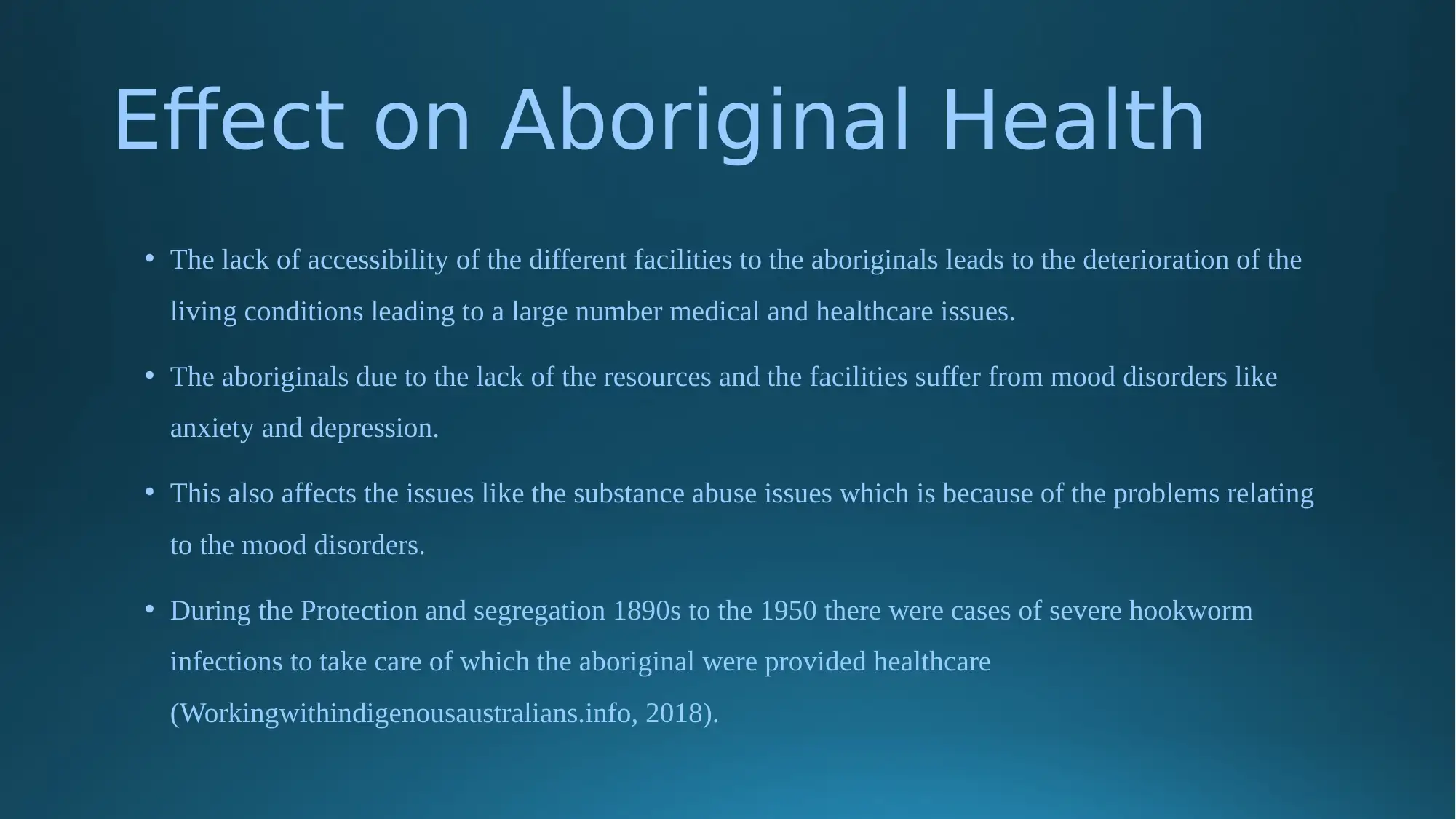
Effect on Aboriginal Health
• The lack of accessibility of the different facilities to the aboriginals leads to the deterioration of the
living conditions leading to a large number medical and healthcare issues.
• The aboriginals due to the lack of the resources and the facilities suffer from mood disorders like
anxiety and depression.
• This also affects the issues like the substance abuse issues which is because of the problems relating
to the mood disorders.
• During the Protection and segregation 1890s to the 1950 there were cases of severe hookworm
infections to take care of which the aboriginal were provided healthcare
(Workingwithindigenousaustralians.info, 2018).
• The lack of accessibility of the different facilities to the aboriginals leads to the deterioration of the
living conditions leading to a large number medical and healthcare issues.
• The aboriginals due to the lack of the resources and the facilities suffer from mood disorders like
anxiety and depression.
• This also affects the issues like the substance abuse issues which is because of the problems relating
to the mood disorders.
• During the Protection and segregation 1890s to the 1950 there were cases of severe hookworm
infections to take care of which the aboriginal were provided healthcare
(Workingwithindigenousaustralians.info, 2018).
⊘ This is a preview!⊘
Do you want full access?
Subscribe today to unlock all pages.

Trusted by 1+ million students worldwide
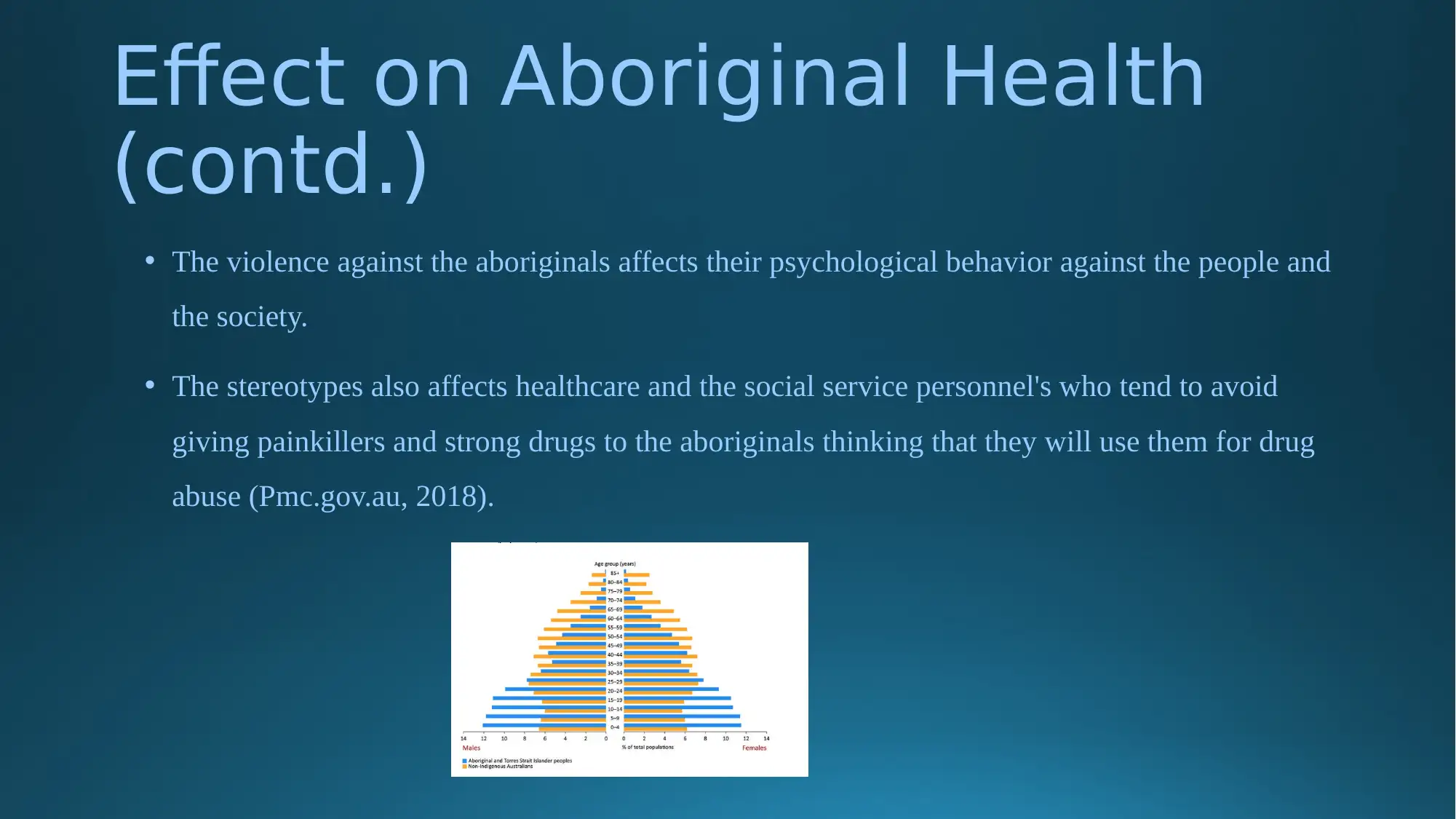
Effect on Aboriginal Health
(contd.)
• The violence against the aboriginals affects their psychological behavior against the people and
the society.
• The stereotypes also affects healthcare and the social service personnel's who tend to avoid
giving painkillers and strong drugs to the aboriginals thinking that they will use them for drug
abuse (Pmc.gov.au, 2018).
(contd.)
• The violence against the aboriginals affects their psychological behavior against the people and
the society.
• The stereotypes also affects healthcare and the social service personnel's who tend to avoid
giving painkillers and strong drugs to the aboriginals thinking that they will use them for drug
abuse (Pmc.gov.au, 2018).
Paraphrase This Document
Need a fresh take? Get an instant paraphrase of this document with our AI Paraphraser
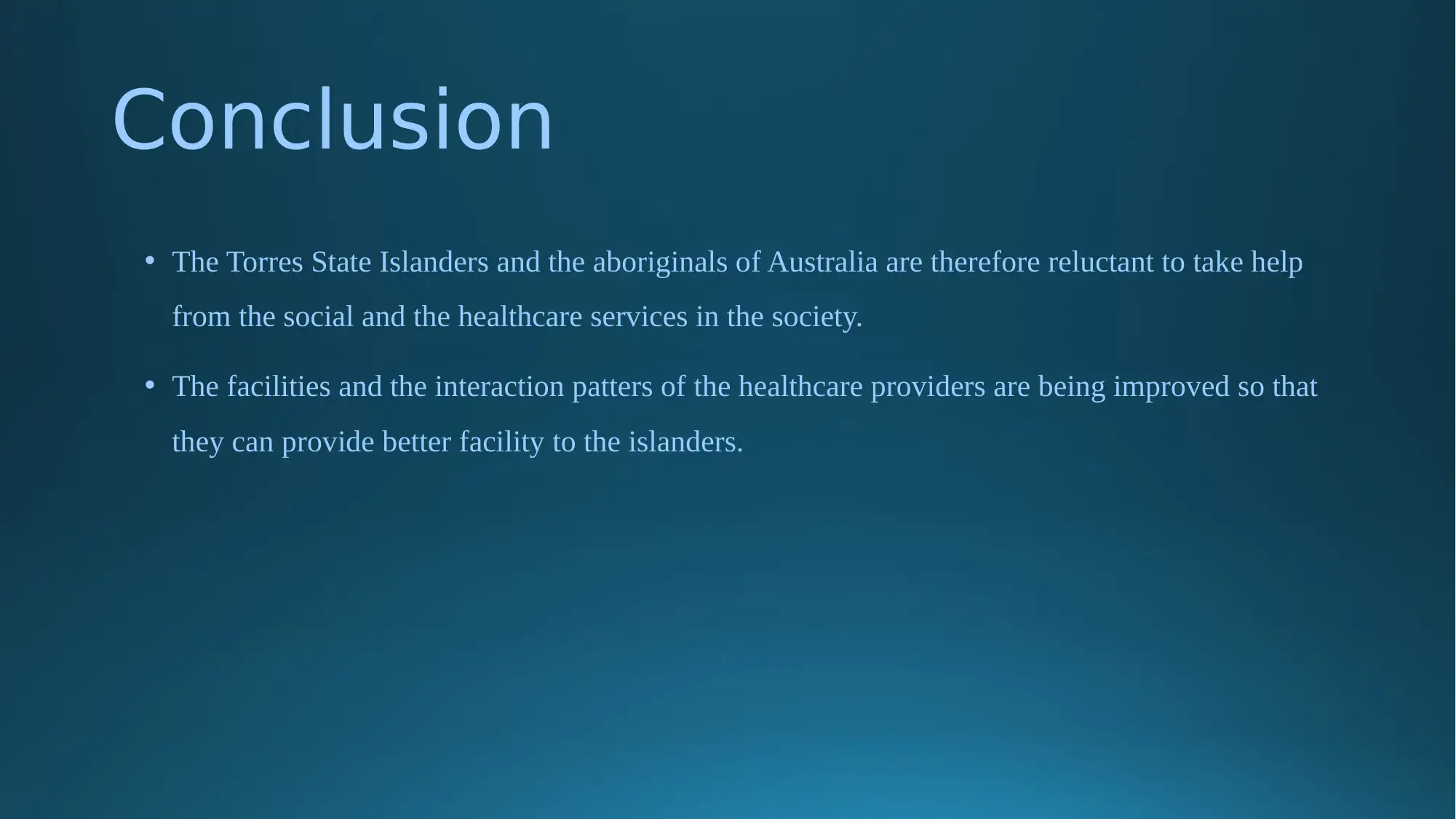
Conclusion
• The Torres State Islanders and the aboriginals of Australia are therefore reluctant to take help
from the social and the healthcare services in the society.
• The facilities and the interaction patters of the healthcare providers are being improved so that
they can provide better facility to the islanders.
• The Torres State Islanders and the aboriginals of Australia are therefore reluctant to take help
from the social and the healthcare services in the society.
• The facilities and the interaction patters of the healthcare providers are being improved so that
they can provide better facility to the islanders.
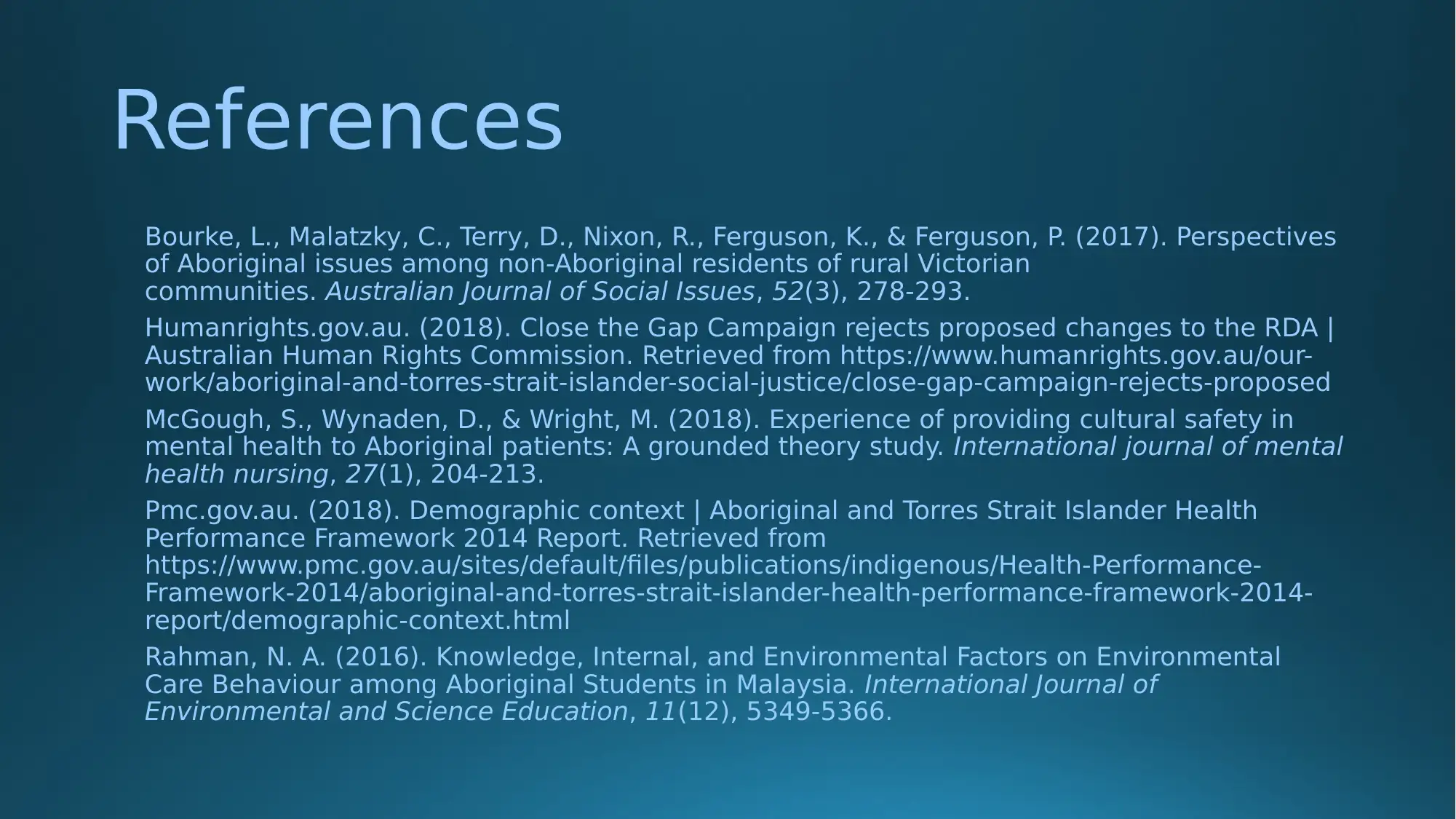
References
Bourke, L., Malatzky, C., Terry, D., Nixon, R., Ferguson, K., & Ferguson, P. (2017). Perspectives
of Aboriginal issues among non‐Aboriginal residents of rural Victorian
communities. Australian Journal of Social Issues, 52(3), 278-293.
Humanrights.gov.au. (2018). Close the Gap Campaign rejects proposed changes to the RDA |
Australian Human Rights Commission. Retrieved from https://www.humanrights.gov.au/our-
work/aboriginal-and-torres-strait-islander-social-justice/close-gap-campaign-rejects-proposed
McGough, S., Wynaden, D., & Wright, M. (2018). Experience of providing cultural safety in
mental health to Aboriginal patients: A grounded theory study. International journal of mental
health nursing, 27(1), 204-213.
Pmc.gov.au. (2018). Demographic context | Aboriginal and Torres Strait Islander Health
Performance Framework 2014 Report. Retrieved from
https://www.pmc.gov.au/sites/default/files/publications/indigenous/Health-Performance-
Framework-2014/aboriginal-and-torres-strait-islander-health-performance-framework-2014-
report/demographic-context.html
Rahman, N. A. (2016). Knowledge, Internal, and Environmental Factors on Environmental
Care Behaviour among Aboriginal Students in Malaysia. International Journal of
Environmental and Science Education, 11(12), 5349-5366.
Bourke, L., Malatzky, C., Terry, D., Nixon, R., Ferguson, K., & Ferguson, P. (2017). Perspectives
of Aboriginal issues among non‐Aboriginal residents of rural Victorian
communities. Australian Journal of Social Issues, 52(3), 278-293.
Humanrights.gov.au. (2018). Close the Gap Campaign rejects proposed changes to the RDA |
Australian Human Rights Commission. Retrieved from https://www.humanrights.gov.au/our-
work/aboriginal-and-torres-strait-islander-social-justice/close-gap-campaign-rejects-proposed
McGough, S., Wynaden, D., & Wright, M. (2018). Experience of providing cultural safety in
mental health to Aboriginal patients: A grounded theory study. International journal of mental
health nursing, 27(1), 204-213.
Pmc.gov.au. (2018). Demographic context | Aboriginal and Torres Strait Islander Health
Performance Framework 2014 Report. Retrieved from
https://www.pmc.gov.au/sites/default/files/publications/indigenous/Health-Performance-
Framework-2014/aboriginal-and-torres-strait-islander-health-performance-framework-2014-
report/demographic-context.html
Rahman, N. A. (2016). Knowledge, Internal, and Environmental Factors on Environmental
Care Behaviour among Aboriginal Students in Malaysia. International Journal of
Environmental and Science Education, 11(12), 5349-5366.
⊘ This is a preview!⊘
Do you want full access?
Subscribe today to unlock all pages.

Trusted by 1+ million students worldwide
1 out of 14
Related Documents
Your All-in-One AI-Powered Toolkit for Academic Success.
+13062052269
info@desklib.com
Available 24*7 on WhatsApp / Email
![[object Object]](/_next/static/media/star-bottom.7253800d.svg)
Unlock your academic potential
Copyright © 2020–2025 A2Z Services. All Rights Reserved. Developed and managed by ZUCOL.





